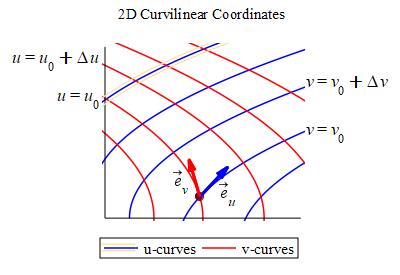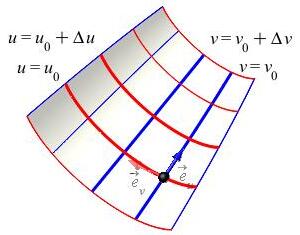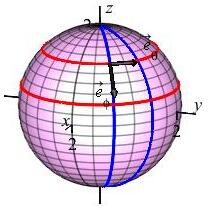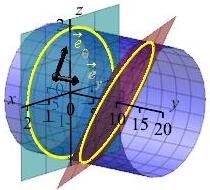22. Parametric Surfaces and Surface Integrals
b. Tangent and Normal Vectors
2. Tangent Vectors
For a 2D curvilinear coordinate system \(\vec R(u,v)\), the coordinate tangent vectors are the tangent vectors to the coordinate curves. \[ \vec e_u=\dfrac{\partial\vec R}{\partial u} =\left\langle \dfrac{\partial x}{\partial u}, \dfrac{\partial y}{\partial u} \right\rangle \quad \text{and} \quad \vec e_v=\dfrac{\partial\vec R}{\partial v} =\left\langle \dfrac{\partial x}{\partial u}, \dfrac{\partial y}{\partial u} \right\rangle \] \(\vec e_u\) is tangent to the \(u\)-curves and points in the direction of increasing \(u\). \(\vec e_v\) is tangent to the \(v\)-curves and points in the direction of increasing \(v\).
We do the same thing for parametric surfaces:

The tangent vector to the \(u\)-curves is
\[
\vec{e}_u=\dfrac{\partial\vec R}{\partial u}
=\left\langle
\dfrac{\partial x}{\partial u},
\dfrac{\partial y}{\partial u},
\dfrac{\partial z}{\partial u}
\right\rangle
\]
which points in the direction of increasing \(u\).
The tangent vector to the \(v\)-curves is
\[
\vec{e}_v=\dfrac{\partial\vec R}{\partial v}
=\left\langle
\dfrac{\partial x}{\partial v},
\dfrac{\partial y}{\partial v},
\dfrac{\partial z}{\partial v}
\right\rangle
\]
which points in the direction of increasing \(v\).

The vector \(\vec{e}_u\) (as well as \(\vec{e}_v\)) is analogous to the to tangent (or velocity) vector to a parametric curve, \(\vec r(t)=\left\langle x(t),y(t),z(t)\right\rangle\), given by: \[ \vec{v}=\dfrac{d\vec r}{dt} =\left\langle \dfrac{dx}{dt},\dfrac{dy}{dt},\dfrac{dz}{dt}\right\rangle \] with the following exceptions:
- The parameter for \(\vec R(u,v_0)\) is \(u\) rather than \(t\); so we need to differentiate the with respect to \(u\).
- Since the \(v\)-coordinate is held constant at \(v_0\), the derivative needs to be a partial derivative with respect to \(u\) instead of a total derivative with respect to \(t\).
- We do not refer to the tangent vector as a velocity because the parameter, \(u\), represents a coordinate on the surface, not a time.
- We use the symbols \(\vec e_u\) and \(\vec e_v\) rather than the letter \(\vec{v}\) for the tangent vectors, because they are not velocities and also because we have already used \(v\) for a parameter.
Find the tangent vectors to the sphere of radius \(\rho=2\), parametrized by: \[ \vec R(\phi,\theta) =\left\langle 2\sin\phi\cos\theta,2\sin\phi\sin\theta,2\cos\phi\right\rangle \]

The tangent vectors to the \(\phi\) and \(\theta\) curves are \[\begin{aligned} \vec{e}_\phi&=\dfrac{\partial\vec R}{\partial\phi} =\left\langle 2\cos\phi\cos\theta,2\cos\phi\sin\theta,-2\sin\phi\right\rangle \\ \vec{e}_\theta&=\dfrac{\partial\vec R}{\partial\theta} =\left\langle -2\sin\phi\sin\theta,2\sin\phi\cos\theta,\quad 0\quad \right\rangle \end{aligned}\] Notice that \(\vec{e}_\theta\) is horizontal since it is tangent to a line of latitude and it points East in the direction of increasing \(\theta\). Similarly, \(\vec{e}_\phi\) points South, tangent to a line of longitude, in the direction of increasing \(\phi\).
Compute the tangent vectors to the paraboloid \(z=\dfrac{x^2+y^2}{5}\) parametrized by: \[ \vec R(r,\theta) =\left\langle r\cos\theta,r\sin\theta,\dfrac{r^2}{5}\right\rangle \]

\(\begin{aligned} \vec e_r&=\left\langle \cos\theta,\sin\theta,\dfrac{2r}{5}\right\rangle \\ \vec e_\theta&=\left\langle -r\sin\theta,r\cos\theta,0\right\rangle \end{aligned}\)
We simply compute: \[\begin{aligned} \vec e_r&=\dfrac{\partial\vec R}{\partial r} =\left\langle \cos\theta,\sin\theta,\dfrac{2r}{5}\right\rangle \\ \vec e_\theta&=\dfrac{\partial\vec R}{\partial\theta} =\left\langle -r\sin\theta,r\cos\theta,0\right\rangle \end{aligned}\]
Find the tangent vectors to the piece of the cylinder \(x^2+z^2=4\) between \(y=0\) and \(y=10+2x+3z\) parametrized by: \[ \vec R(\theta,y)=\left\langle 2\cos\theta,y,2\sin\theta\right\rangle \]

\(\begin{aligned} \vec e_\theta&=\left\langle -2\sin\theta,0,2\cos\theta\right\rangle \\ \vec e_y&=\left\langle 0,1,0\right\rangle \end{aligned}\)
We simply compute: \[\begin{aligned} \vec e_\theta&=\dfrac{\partial\vec R}{\partial\theta} =\left\langle -2\sin\theta,0,2\cos\theta\right\rangle \\ \vec e_y&=\dfrac{\partial\vec R}{\partial y} =\left\langle 0,1,0\right\rangle \end{aligned}\]
Notice the parameter ranges have absolutely nothing to do with the tangent vectors. They only affect the limits of integration.
Heading
Placeholder text: Lorem ipsum Lorem ipsum Lorem ipsum Lorem ipsum Lorem ipsum Lorem ipsum Lorem ipsum Lorem ipsum Lorem ipsum Lorem ipsum Lorem ipsum Lorem ipsum Lorem ipsum Lorem ipsum Lorem ipsum Lorem ipsum Lorem ipsum Lorem ipsum Lorem ipsum Lorem ipsum Lorem ipsum Lorem ipsum Lorem ipsum Lorem ipsum Lorem ipsum